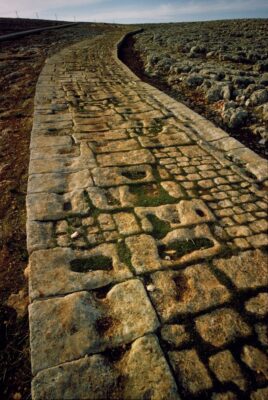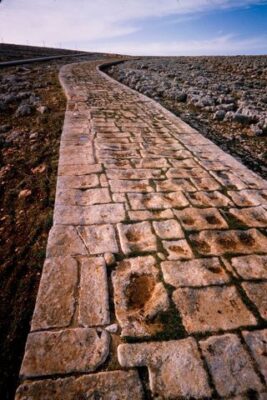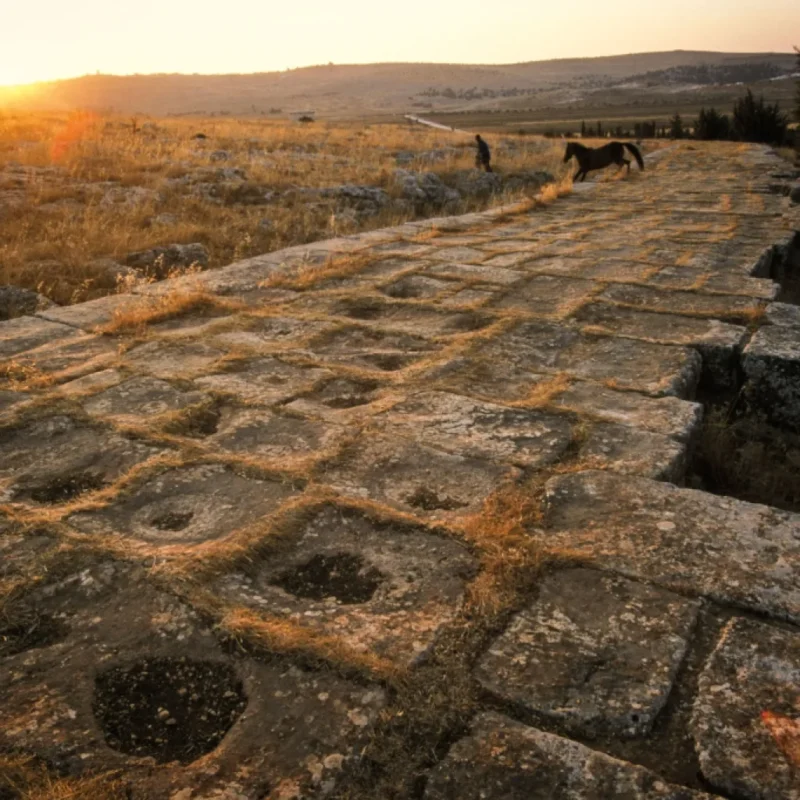The Ancient Roman Road Connecting Antakya and Aleppo in Turkey and in Syria stands as a testament to the engineering prowess of the Roman Empire. Built over two thousand years ago, this ancient road was more than just a means of travel; it was a major infrastructure project that played a crucial role in the empire’s ability to control vast territories. Today, parts of this ancient road still remain, showcasing the enduring legacy of Roman engineering and their remarkable construction techniques. Follow archeology.dulichvn.net to discover many hidden mysteries that have yet to be discovered.

The Engineering Marvel of Roman Roads
Roman roads were not just functional pathways but feats of engineering that demonstrated the empire’s advanced understanding of construction. The road connecting Antakya and Aleppo is a prime example of Roman infrastructure, designed to facilitate communication, trade, and military movement across vast distances.
Precision in Construction
Roman engineers were known for their attention to detail and precision when constructing roads. The road between Antakya and Aleppo was no exception. These roads were built with multiple layers, including a foundation of large stones, a middle layer of gravel, and a top layer of tightly fitted paving stones. This design not only ensured durability but also improved the stability of the road for long-term use.
Advanced Surveying Techniques
The Romans also used advanced surveying techniques to ensure their roads followed the most efficient routes. This involved the use of tools like the groma and dioptra, allowing engineers to create straight and level paths, even across difficult terrain. The road between Antakya and Aleppo was no different, as it passed through diverse landscapes while maintaining a consistent, level surface.
Durability That Withstood the Ages
One of the most remarkable aspects of Roman roads, including the Antakya-Aleppo route, is their durability. Built with an intricate design and using high-quality materials, these roads were capable of withstanding the wear and tear of constant use. Even after centuries of use and exposure to the elements, parts of the road still exist today, highlighting the effectiveness of Roman construction methods.

The Importance of the Antakya-Aleppo Road in Roman Times
The road that connected Antakya and Aleppo played a crucial role in the Roman Empire, particularly in facilitating trade, military operations, and communication across a vast territory.
Facilitating Trade and Commerce
As a major route for the exchange of goods, the road between Antakya and Aleppo was essential for trade. Goods such as spices, silk, and other commodities from the East were transported through this route, connecting Roman markets with those in the Middle East and Asia. The efficient transportation network allowed for the flow of goods and wealth, contributing to the empire’s economic prosperity.
Military Movements and Strategic Importance
Roman roads were also vital for military efficiency. The road between Antakya and Aleppo allowed Roman legions to travel quickly and efficiently across the empire’s eastern frontier, ensuring that the Roman military could respond rapidly to threats. The road was strategically important, enabling the Romans to maintain control over vast regions, including parts of modern-day Syria and Turkey.
Strengthening Roman Administration
The road also played a critical role in maintaining Roman administration over distant provinces. By connecting key cities and military outposts, it enabled Roman governors and officials to travel more easily, facilitating governance and the enforcement of Roman laws and policies. This road helped maintain the unity of the Roman Empire by ensuring that central authority could be projected across distant regions.

The Lasting Legacy of Roman Infrastructure
The road between Antakya and Aleppo is a lasting reminder of the Roman Empire’s infrastructure and its impact on the modern world. The Roman commitment to engineering excellence has had a profound influence on road construction throughout history, setting the standard for future civilizations.
Roman Roads as a Model for Future Engineering
Roman road-building techniques have influenced road construction for centuries. Many modern highways and roads still follow the same basic principles established by Roman engineers. The enduring legacy of Roman roads, such as the Antakya-Aleppo route, continues to shape the way we design and build transportation networks today.
Preserving Ancient Roads for Future Generations
Despite the passage of time, sections of the Antakya-Aleppo road still exist, and efforts are being made to preserve these ancient structures. Archaeologists and conservationists work to protect these roads as cultural heritage sites, ensuring that future generations can appreciate the remarkable engineering feats of the Romans.
The Impact on Modern Infrastructure
The Roman road network was one of the most advanced systems of its time, and its influence can still be seen in modern infrastructure. The techniques used by Roman engineers, from surveying and road layering to the use of durable materials, have been passed down through the ages and continue to inform the design and construction of roads today. The Antakya-Aleppo road serves as a lasting symbol of the Roman Empire’s legacy in modern infrastructure development.
See more: The Terracotta Warriors: Secrets of Qin Shi Huang’s Tomb
Conclusion: The Timeless Quality of Roman Engineering
The ancient Roman road connecting Antakya and Aleppo is a remarkable example of the Roman Empire’s engineering skill and foresight. Built over two thousand years ago, its construction remains a testament to the advanced knowledge of Roman engineers who designed roads that could endure the test of time. Today, parts of this road still exist, highlighting the lasting impact of Roman infrastructure on the world. The road’s precision, durability, and strategic importance reflect the greatness of the Roman Empire and its lasting influence on modern engineering practices.


CÁC TIN KHÁC
Mary Walton: The Forgotten Inventor Who Helped Clean Up America’s Cities
Tomb of Queen Nefertari in the Valley of the Queens, Egypt
Discover the Hypostyle Hall of the Temple of Hathor at Dendera
Venus de Losange: Unveiling the Mystery of a 20,000-Year-Old Paleolithic Icon